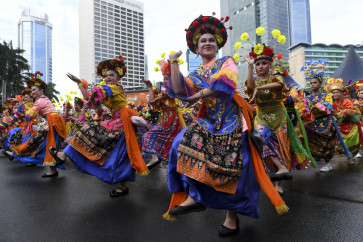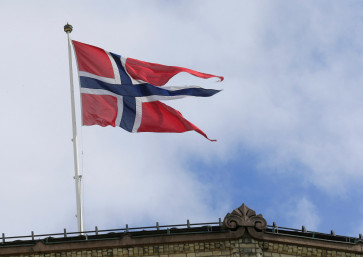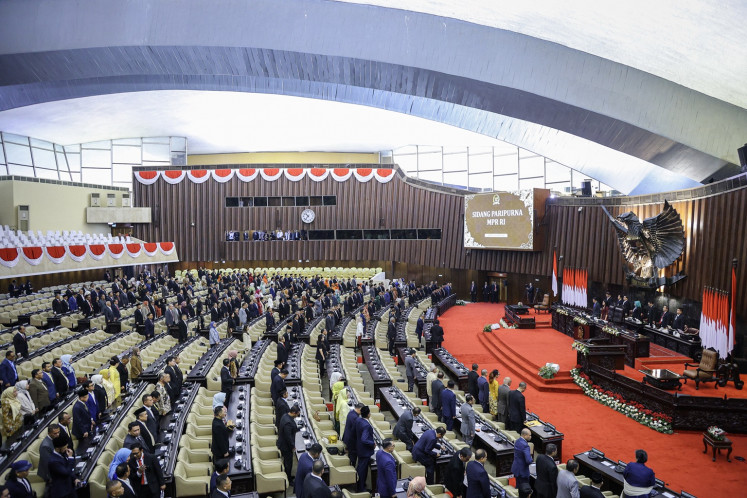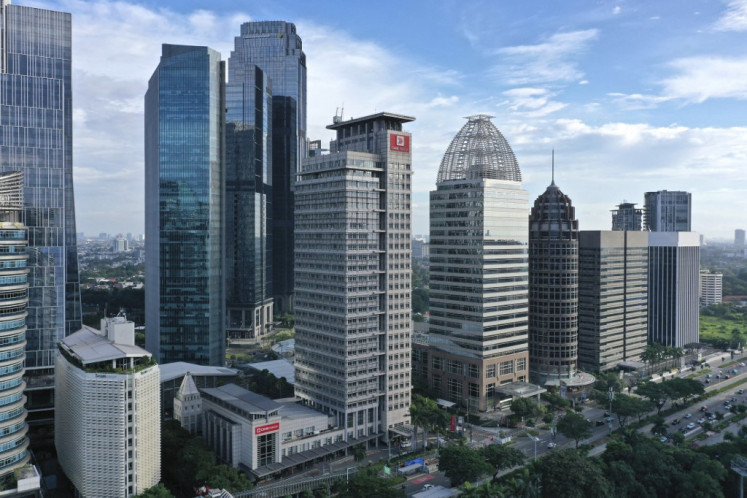Popular Reads
Top Results
Can't find what you're looking for?
View all search resultsPopular Reads
Top Results
Can't find what you're looking for?
View all search resultsSimple scenes by simple means
On the Ring Road: A visitor looks at the woodcut prints by graphic artist Syahrizal Pahlevi as part of the “Print Project — Yang Melintas di Ring Road”
Change text size
Gift Premium Articles
to Anyone
O
span class="caption">On the Ring Road: A visitor looks at the woodcut prints by graphic artist Syahrizal Pahlevi as part of the “Print Project — Yang Melintas di Ring Road”. JP/R. Berto Wedhatama
There’s always something intriguing about the things we see everyday. No matter how familiar they are, there’s always space to step back and contemplate them.
Capturing those scenes through the medium of graphic art woodcuts, Yogyakarta-based artist Syahrizal Pahlevi is presenting his latest series “Print Project: Those who pass on the Ring Road” at
Central Jakarta’s Bentara Budaya Jakarta.
Why the Ring Road?
It’s part of his everyday life: The view from his home just 100 meters from the road; a road he takes on his way to an exhibition, to a friend’s place, to the market, or just for a walk with his family.
Presenting a certain directional perspective, the Ring Road also provides room for contemplation amid the hustle and bustle of lines and shapes that form it, exhibition curator Aminuddin TH Siregar said in commenting on the works.
“Pahlevi, as if responding to the realism that S. Sudjono talked about in the 1930s, presented whatever caught his eye. Consequently, trucks, cars, electrical poles, trees and roads are present,” he added.
“They remain unusually uncensored for the sake of the artists’ artistic pursuit.”
For Pahlevi, the freeway paradoxically provides its users with freedom from dealing with
speed humps, traffic lights and crossroads, while simultaneously keeping them on guard against the dangers of this freedom that encourages motorists to press the pedal to the floor.
But there’s more to see and experience from the so-called Ring Road: Cars trying to overtake slower-moving trucks, buses speeding like crazy, pedestrians lining the scene, even traffic signs and electric poles in the distance.
In this current work, Pahlevi chooses woodcuts in monochromes as he felt the subject matter to be one that requires a simple, straightforward presentation.
He also expands the scale of his work from the previous small and medium-size pieces of paper into a larger canvas, spanning 8.5 meters.
Why woodcuts?
Why not? Pahlevi replies. For him, it is one medium that always leaves him wanting more.
“There’s always something new that you feel you need to try with it,” he says. “Something to fix, something to develop.”
During one phase, Pahlevi started working on colored woodcut works, a method that requires additional meticulous processing.
Adding color to woodcut works thus becomes a form of restraint for artists.
“However, for me personally, Pahlevi has been able to conquer the restraints and come up with dynamic works as if he has been able to conquer his chisel,” Siregar says.
Woodcut itself is perhaps the most frequently adopted medium for graphic artists.
The fact that woodcut requires no special studio equipment — unlike intaglio, silk-screen printing or lithography — makes it more popular, he adds.
Yet its presence is still often deemed second class compared with other mediums.
“The public is so distanced from graphic art,” the curator adds. “It’s quite rare to see the
works in any exhibition, be it solo or group.”
The art of carving a relief on a block of wood developed back in the early 5th century as a way to produce and reproduce certain decorative elements or scripts.
A millennium later, the method developed into a more sophisticated printing method using metal plates, the root of the intaglio medium.
In Indonesia, the woodcut technique was introduced in the 17th century as a method to produce illustrations for printed materials.
Along with other graphic art mediums, woodcut became the medium for producing propaganda
materials in the 1930s and 1940s. Among its pioneers were Mochtar Apin and Baharudin Marasutan, who worked on a series to be distributed to fuel the Indonesian pro-independence spirit.
It then rapidly developed during the 1950s as illustrations for printed poetry and prose.
Currently, Pahlevi is among the few in the art world in general that work — although not exclusively —with woodcut techniques.
That the woodcut can then be easily reproduced is perhaps what leads to the marginalization of this kind of work in being considered art. As long as the plates are there, an artist can freely print the works over and over.
This doesn’t bother Pahlevi.
“That’s just the consequences of the technique,” he says. “Art will remain art.”










